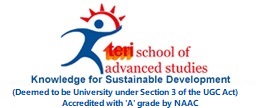
ANNOUNCEMENTS

| Date | News Title | Source |
| 18-July-2025 | 1 in 4 Indian married couples ... | The Indian Express |
| 23-June-2025 | Blended Learning: Driving educ... | The Pioneer |
| 22-June-2025 | All adults overweight in every... | |
| 21-June-2025 | TERI SAS Nurturing Global Sust... | The Interview World (Online) |
| 27-May-2025 | Eco-education trend grows: Sus... | India Today (Online- Education Desk) |
| 25-March-2025 | How water green credits can fu... | Hindustan Times (Opinion) |
| 23-February-2025 | Sustainable biz practices disc... | The Times of India (Online) |
| 21-February-2025 | Sangam fit for bath’, Enviro... | News9 (Online) |
| 12-February-2025 | A role for India in South-Sout... | The Hindu (Online) |
| 02-December-2024 | ICAR Findings Show 34% Decline... | ETV Bharat (Online) |
The world runs on energy and devices that store energy whether it’s the supercapacitor, lithium batteries or even the solar panels have done wonders to change our lives and make it as comfortable as it gets. Now to further improve upon the storage of energy, academicians cum researchers from two different Indian institutions teamed up and developed a new carbon based nano material for future improvement in supercapacitor energy storage technology development.
Ms Rinki Malik, Ms Priyank Rani, Dr Suman Lata, Dr Udit Soni, and Dr Rajender Singh Malik have developed a more effective way to store energy as the four academicians used direct electrochemical method to synthesize novel porous nanostructure carbon and polymer composites. Assistant Professor Dr Rajender Singh Malik was team leader from Deenbandhu Chhotu Ram University of Science and Technology, Haryana and Assistant Professor Dr Udit Soni was from prestigious TERI School of Advanced Studies (TERI SAS), New Delhi.
This new carbon based nano material is termed as “PPy/CQDs” and improve the electron transfer with a reduction in the internal resistance and charge transfer resistance which makes the transfer of energy faster and more efficient.
The research paper highlighting the major development unearthed by four academicians was published in international journal Electrochimica Acta, Science Direct, Elsevier.
The abstract of the research paper published in the journal reads, “Polypyrrole (PPy) and carbon quantum dots (CQDs) based composite electrodes (PPy/CQDs or PQDs) are designed through one step electro-polymerization technique in aqueous solution for energy storage purposes. Composite electrode, thus obtained exhibits good electrochemical properties due to dotted CQDs structure comprising of high surface area with numerous active sites. Electrical conductivity of PPy was improved noticeably after modifying with CQDs. The charge transfer resistance (Rp) diminishes from 2.7 Ω to 0.11 Ω for PQD composite due to fast charge diffusion.
The impact of varied concentration of CQDs was also evaluated for optimizing the electrochemical behavior of PQDs composites and PPy: CQDs as 95: 5 w/w ratio designated as PQD 0.5 was found to be the most effective composition. Various electrochemical properties of PQDs are also correlated at different time intervals to get an effective electro-polymerized output and observed that PQD 0.5 composition processed for 30 min (PQD 30) demonstrates high specific capacitance of 1073.5 F/g at a scan rate of 10 mV/s and mass loading with 1.4 g/cm2 of the optimized composite with a good cyclic stability as 62% even after 2000 cycles of charge/discharge for the electrode.”
Dr Soni says that team could have taken patent for it but the team believes in making affordable and efficient energy storage available for the people and therefore leaves it open to other people who can use this development and further make energy storage methods more effective and easily accessible. Dr Malik also has pointed out that this electrode nano composite material could be highly useful for supercapacitor application such as rapid electrical charging. Presently this work is in initial stage and the team is working on development of energy storage supercapacitor electrical devices by using this electrode material. This new electrode material has huge potential to contribute in supercapacitor sector.
Plot No. 10, Institutional Area, Vasant Kunj, New Delhi - 110 070, India.
Tel. +91 11 71800222 (25 lines).
Website : www.terisas.ac.in
Email id : registrar@terisas.ac.in
© Copyright © 2025, TERI SAS, All rights reserved.
Visitors No.: 46425184 Since 2023


